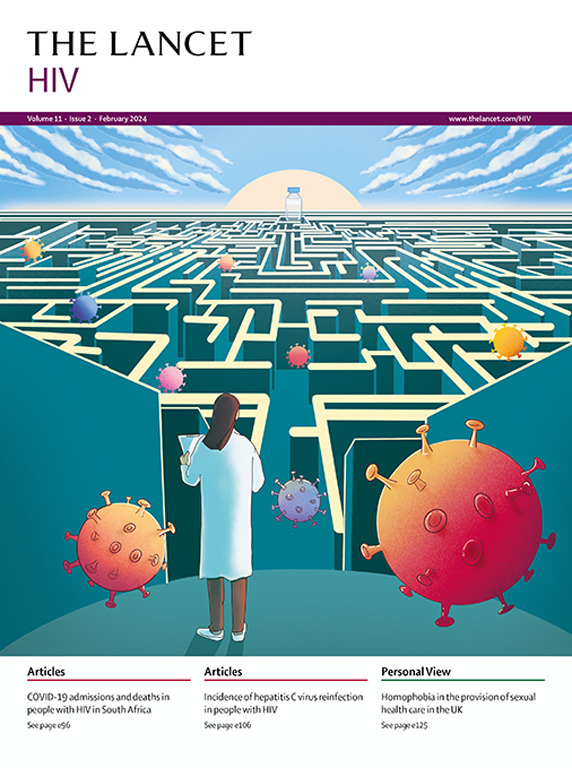在未接受抗逆转录病毒治疗的艾滋病毒感染者中,同时开始以多替格雷韦为基础的抗逆转录病毒治疗和每周一次的利福喷丁和异烟肼预防结核病:一项开放标签、非随机、1/2期试验
IF 13
1区 医学
Q1 IMMUNOLOGY
引用次数: 0
摘要
结核病预防治疗:每周一次异烟肼(900毫克)和利福喷丁(900毫克;3HP)是艾滋病毒感染者的推荐选择;在有病毒学抑制的成人中,3HP方案联合多替地韦抗逆转录病毒治疗(ART)是安全的,并能维持病毒学抑制。DOLPHIN-TOO研究评估了在未接受过抗逆转录病毒治疗的成年HIV患者中,同时开始使用多替格雷韦的ART和3HP的安全性、药代动力学和病毒学疗效。方法dolphin - too是在Aurum Institute Tembisa临床研究中心(Tembisa,南非)进行的一项非随机、开放标签、实用的1/2期试验。顺序招募未接受抗逆转录病毒治疗且无结核病症状或微生物学证实无结核病的HIV感染成人(年龄≥18岁),并分配6个月每日一次异烟肼300 mg (6H;n=25)或3HP (n=50)。第0天开始使用多替重力韦50 mg、富马酸替诺福韦二氧吡酯300 mg和拉米夫定300 mg,第1天开始使用结核病预防治疗;在治疗第1天(开始3HP或6H之前)、第3周(第17天)和第8周(第52天)进行多替韦的稀疏药代动力学采样。通过PCR连续检测HIV-1 RNA病毒载量。主要终点是不良事件(根据艾滋病不良事件分级表2.1版的3级或更糟),以及使用6H作为药代动力学对照,使用和不使用3HP的多替重力韦的人群药代动力学。采用非线性混合效应模型进行药代动力学分析。安全性和药代动力学的分析人群为意向治疗人群。该试验已在南非国家临床试验登记处(DOH-27-1217-5770)和ClinicalTrials.gov (NCT03435146)注册,并已完成。研究结果:从2021年8月31日至2022年6月28日,75名受试者被顺序入组,并被分配到6H组(n=25)或3HP组(n=50)。参与者的总体中位年龄为35岁(IQR 27-41),所有参与者均为非洲黑人,其中37人(49%)为女性,38人(51%)为男性。基线时,总体中位HIV病毒载量为27056拷贝/ mL (IQR 7088-111 620), 20名(27%)参与者的HIV病毒载量高于100,000拷贝/ mL;中位基线CD4计数为283个细胞/ μL。报告了1例3级或更严重的不良事件:6H组一名参与者出现3级皮肤脓肿,需要住院治疗(与治疗无关)。未发生与治疗相关的3级不良事件。共给药3HP使dolutegravity清除率提高了72%(相对标准误差12%),从3HP治疗前的0.95 L/h提高到3HP治疗期间的1.64 L/h。在第3周,3HP组的中位多替替韦谷浓度显著低于6H组(720 ng/mL[范围92-4250]vs 1310 ng/mL[范围431-2980];Wilcoxon秩和p= 0.0006)和第8周(669 ng/mL [184-4440] vs 1285 ng/mL [475-2890];p = 0·0066)。所有多替替韦谷值均高于体外蛋白调节的多替替韦90%最大抑制浓度64 ng/mL。我们的研究结果表明,同时开始3HP结核病预防治疗和基于多替格拉韦的抗逆转录病毒治疗是安全的,并且在未接受抗逆转录病毒治疗的HIV患者中达到治疗浓度,不需要调整多替格拉韦的剂量。unitaid, ViiV Healthcare。翻译摘要的南非荷兰语、科萨语和祖鲁语翻译见补充材料部分。本文章由计算机程序翻译,如有差异,请以英文原文为准。
Simultaneous initiation of dolutegravir-based antiretroviral therapy and once-weekly rifapentine and isoniazid for tuberculosis prevention in antiretroviral-naive people with HIV: an open-label, non-randomised, phase 1/2 trial.
BACKGROUND
Tuberculosis preventive treatment with 3 months of once-weekly isoniazid (900 mg) and rifapentine (900 mg; 3HP) is a recommended option for people with HIV; among adults with virological suppression, the 3HP regimen given with dolutegravir-based antiretroviral therapy (ART) is safe and maintained virological suppression. The DOLPHIN-TOO study assessed safety, dolutegravir pharmacokinetics, and virological efficacy of concurrent initiation of dolutegravir-based ART and 3HP among antiretroviral-naive adults with HIV.
METHODS
DOLPHIN-TOO was a non-randomised, open-label, pragmatic phase 1/2 trial done at The Aurum Institute Tembisa Clinical Research Site (Tembisa, South Africa). Antiretroviral-naive adults (aged ≥18 years) with HIV and no symptoms of tuberculosis disease or microbiologically confirmed absence of tuberculosis disease were sequentially enrolled and assigned to 6 months of once-daily isoniazid 300 mg (6H; n=25) or to 3HP (n=50). Once-daily dolutegravir 50 mg with tenofovir disoproxil fumarate 300 mg and lamivudine 300 mg was initiated on day 0 and tuberculosis preventive treatments were initiated on day 1; sparse pharmacokinetic sampling for dolutegravir was done on day 1 (before starting 3HP or 6H), and in week 3 (day 17) and week 8 (day 52) of treatment. HIV-1 RNA viral loads were measured serially by PCR. The primary endpoints were adverse events (grade 3 or worse per the Division of AIDS Adverse Event Grading Table version 2.1) and population pharmacokinetics of dolutegravir with and without 3HP, using 6H as a pharmacokinetic control. Non-linear mixed-effects modelling was used for pharmacokinetic analysis. The analysis population for both safety and pharmacokinetics was the intention-to-treat population. The trial is registered with the South African National Clinical Trials Register, DOH-27-1217-5770, and ClinicalTrials.gov, NCT03435146, and is completed.
FINDINGS
75 participants were sequentially enrolled from Aug 31, 2021, to June 28, 2022, and assigned to 6H (n=25) or 3HP (n=50). Overall median age of participants was 35 years (IQR 27-41), all participants were Black African, and 37 (49%) were female and 38 (51%) were male. At baseline, overall median HIV viral load was 27 056 copies per mL (IQR 7088-111 620), and 20 (27%) participants had HIV viral loads higher than 100 000 copies per mL; median baseline CD4 count was 283 cells per μL. One grade 3 or worse adverse event was reported: a grade 3 cutaneous abscess requiring hospitalisation (unrelated to treatment) in a participant in the 6H group. No treatment-related grade 3 adverse events occurred. Coadministered 3HP increased dolutegravir clearance by 72% (relative standard error 12%), from 0·95 L/h before 3HP treatment to 1·64 L/h during 3HP treatment. Median dolutegravir trough concentrations were significantly lower in the 3HP group than in the 6H group at week 3 (720 ng/mL [range 92-4250] vs 1310 ng/mL [431-2980]; Wilcoxon rank-sum p=0·0006) and week 8 (669 ng/mL [184-4440] vs 1285 ng/mL [475-2890]; p=0·0066). All dolutegravir trough values were higher than the in-vitro protein-adjusted 90% maximal inhibitory concentration for dolutegravir of 64 ng/mL.
INTERPRETATION
Our results indicate that simultaneous initiation of 3HP tuberculosis preventive treatment and dolutegravir-based ART was safe and achieved therapeutic concentrations among antiretroviral-naive individuals with HIV, and dolutegravir dose adjustments are not needed.
FUNDING
Unitaid, ViiV Healthcare.
TRANSLATIONS
For the Afrikaans, Xhosa and Zulu translations of the abstract see Supplementary Materials section.
求助全文
通过发布文献求助,成功后即可免费获取论文全文。
去求助
来源期刊

Lancet Hiv
IMMUNOLOGYINFECTIOUS DISEASES&-INFECTIOUS DISEASES
CiteScore
19.90
自引率
4.30%
发文量
368
期刊介绍:
The Lancet HIV is an internationally trusted source of clinical, public health, and global health knowledge with an Impact Factor of 16.1. It is dedicated to publishing original research, evidence-based reviews, and insightful features that advocate for change in or illuminates HIV clinical practice. The journal aims to provide a holistic view of the pandemic, covering clinical, epidemiological, and operational disciplines. It publishes content on innovative treatments and the biological research behind them, novel methods of service delivery, and new approaches to confronting HIV/AIDS worldwide. The Lancet HIV publishes various types of content including articles, reviews, comments, correspondences, and viewpoints. It also publishes series that aim to shape and drive positive change in clinical practice and health policy in areas of need in HIV. The journal is indexed by several abstracting and indexing services, including Crossref, Embase, Essential Science Indicators, MEDLINE, PubMed, SCIE and Scopus.
 求助内容:
求助内容: 应助结果提醒方式:
应助结果提醒方式:


